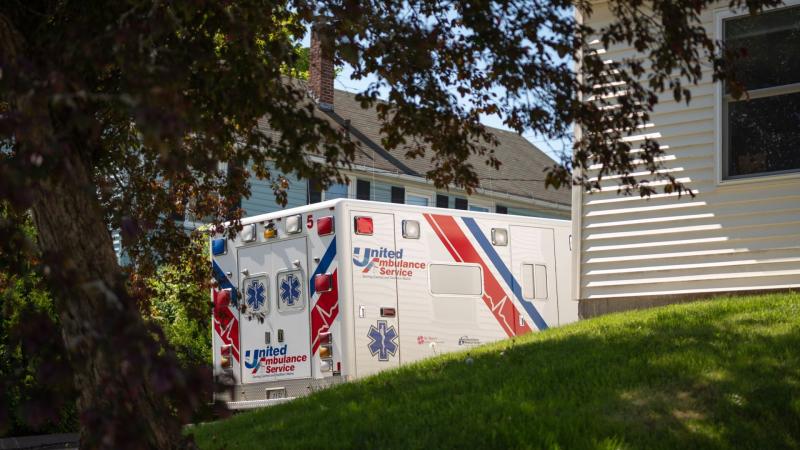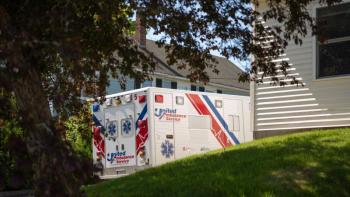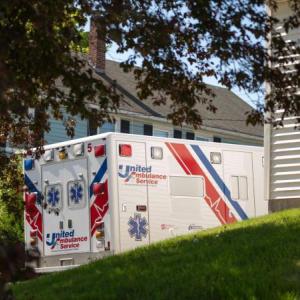Future of community paramedicine in Maine uncertain after federal cuts
 Maine’s community paramedicine program allows EMS providers to make periodic visits to patients to manage chronic conditions such as COPD and hypertension, as well as to follow up with basic medical care, including maintaining wound dressing, administering vaccines and drawing blood. Photo by Garrick Hoffman.
Maine’s community paramedicine program allows EMS providers to make periodic visits to patients to manage chronic conditions such as COPD and hypertension, as well as to follow up with basic medical care, including maintaining wound dressing, administering vaccines and drawing blood. Photo by Garrick Hoffman.
 Maine’s community paramedicine program allows EMS providers to make periodic visits to patients to manage chronic conditions such as COPD and hypertension, as well as to follow up with basic medical care, including maintaining wound dressing, administering vaccines and drawing blood. Photo by Garrick Hoffman.
Maine’s community paramedicine program allows EMS providers to make periodic visits to patients to manage chronic conditions such as COPD and hypertension, as well as to follow up with basic medical care, including maintaining wound dressing, administering vaccines and drawing blood. Photo by Garrick Hoffman.
On a rainy Tuesday morning in early May, Daphne Russell, a community paramedic with United Ambulance Service, knocks on the door of a home in Lewiston. She’s there, as she is each Tuesday, to check on one of her patients: monitoring vitals and sorting through medications.
The visit is a part of a United’s community paramedicine program, in which staff provide free, in-home primary care to patients who have been referred by hospitals or primary care providers, in an effort to reduce hospitalizations and decrease the number of ambulance rides and emergency department visits.
But Russell’s visits with such patients are at risk after the federal government abruptly terminated $1 million in grants to community paramedicine programs in Maine. The latest round of the grants was awarded earlier this year to 10 community paramedicine outfits around the state; each agency was eligible for up to $100,000.The federal government said it was ending the funding because the pandemic is over.
All contracts were halted, said Jason Oko, Maine EMS Regional Manager, in an email. Many of the programs do not have other funding and will likely be forced to stand down, said Oko.
“We anticipate the sudden end of this grant funding will have a substantial impact on our established Systems of Care and Community Paramedicine programs, and will slow our progress in these important areas moving forward,” said Oko.
While Maine technically allows for reimbursement of community paramedicine under government insurance programs such as Medicare and MaineCare (Maine’s version of Medicaid), specific rates and billing procedures are still being refined, and the organizations The Monitor spoke with are not currently being reimbursed by insurance.
The state has indicated they will be considering changes to reimbursement in the near future, but a timeframe is unclear. As a result, most programs in Maine are supported primarily by federal grants.
“We may see programs ratchet back and not provide as many services because of the [new] funding constraints,” said Dennis Russell, operations and community paramedicine manager at United. (Dennis is the brother of Daphne Russell).
Providers said the programs are particularly important in rural areas, which are facing a shortage of primary care physicians and reduction in services as hospitals struggle with workforce shortages and financial issues. A recent Center for Healthcare Quality and Payment Reform report found that nearly half of Maine’s rural hospitals are at risk of closure; four of them are at “immediate risk.”
The state has lost 29 nursing homes in the past decade; in that same time frame, ten hospital-based birthing units have closed or announced that they will close, including four this year, and hospitals have cut back on services around the state, leading to prolonged wait times for appointments and forcing many residents to seek care in emergency rooms.
“With the nursing home being closed, many of our patients are people who should be in a nursing home,” Walter Reed, Memorial Ambulance Corps’ executive director, told Island Ad-Vantages in early May. Memorial Ambulance Corps runs the second largest community paramedicine program in the state, serving Deer Isle and neighboring Stonington. “They depend on us.”
Meanwhile, Maine EMS is itself in a state of financial crisis, facing not only economic concerns but also staffing challenges while also picking up an increased workload as hospitals cut back on services.
A majority of patients transported via ambulance in Maine — upward of 60 to 70 percent, according to Joe Kellner, CEO of LifeFlight Maine — have government-funded insurance, either MaineCare or Medicare. But reimbursement rates from those programs (now facing the possibility of massive federal funding cuts) have not kept pace with the cost of care, forcing ambulance services to cover the gap.
And despite a 2021 law requiring commercial insurance companies to pay more for services, insurers still have wide latitude to deny payment if they deem a transport “medically unnecessary.”
Reimbursement issues, as well as a declining number of volunteers and few patients spread out over a wide geographic area, have resulted in ambulance services closing their doors around the state. A blue-ribbon commission recommended an annual investment of $70 million over five years to stabilize the system; the Legislature allocated $31 million in 2023, but providers warned it would not be enough to offset problems in the long run.
The statewide workforce shortage has exacerbated the situation, particularly in rural areas, where staffing gaps often leave large regions without ambulance coverage. Local EMS providers have been facing difficulties in recruiting and retaining qualified personnel, leading to increased pressure on remaining staff and potential delays in emergency response times.
“There are more and more patients using emergency rooms as their primary care because they can’t get primary care or can’t get into the system to do that,” said Dennis Russell.
Meeting patients in their “true environment”
Maine’s community paramedicine program began in 2012, when the Legislature approved up to 12 pilot sites at ambulance services around the state. The law authorized EMS providers to make periodic visits to patients to manage chronic conditions such as COPD and hypertension, as well as to follow up with basic medical care, including maintaining wound dressing, administering vaccines and drawing blood.
The primary goal when the program started, said Sean Donaghue, who oversees community paramedicine for the Portland Fire Department, known as Mobile Medical Outreach, was to target the highest users of the emergency medical system, those who might call several times a week, or even daily, and to treat “patients who are in the gaps, who don’t have home health, don’t have other resources.”
Community paramedics see people “everywhere,” said Daphne, of United, “from Dunkin’ Donuts to their home, to in a tent… We find ourselves just being advocates for the patients.”
The community paramedicine model is based on a service implemented in New Mexico in the 1990s, and aims to “serve patients earlier in the disease process, reduce unnecessary transports, conserve emergency resources, and take advantage of downtime of rural EMS providers,” according to the authors of a 2015 Maine EMS report.
According to Maine EMS, the state’s 12 paramedicine programs saw roughly 3,550 patients last year. While it’s difficult to determine precisely how much money was saved by keeping someone from visiting an emergency room and research on the subject is scant, a 2020 study of the community paramedicine program in Lincoln County found that the program resulted in savings of roughly $2,139 in avoided hospitalization costs per patient.
In one example from the study, a 72-year-old man insured by Medicare had visited the emergency room three times the month before community paramedics began visiting him; the month after, he never visited the emergency department, resulting in nearly $6,000 in savings.
A 2013 study of nationwide Medicare claims data estimated that, by allowing EMS providers to be reimbursed for non-emergent or primary care calls, the federal government could save $283-$560 million or or more annually ($388-$769 million today). Savings could double if private insurance companies followed suit, the authors noted, and care for patients would also be improved.
“It definitely has reduced calls,” said Donaghue. “When you price it out against hospitals and doctors, it’s actually pretty low cost,” he added, and will help systems “maintain capacity.”
The type of calls handled by community paramedicine programs vary depending on demographics of the county. Many patients in rural areas who utilize the program are older, and need providers who can help assess their home for risk of falls and manage medications and chronic health conditions.
In Portland, said Donaghue, much of the work is with patients struggling with alcohol or substance abuse, or with immigrants who don’t speak fluent English and need help organizing and understanding medication instructions.
“It’s hard enough to access the traditional health care system right now even if you have insurance and a primary care physician,” said Donaghue. “There’s huge, huge demand on the system as a whole.”
Workers who meet patients outside of a traditional physician’s office on a regular basis are also able to provide better care and make note of small changes that could impact their care, said several providers.
Seeing a patient in their “true environment,” said Joshua H. Pobrislo, the manager for Maine Health’s Community Paramedicine, “can alter a care plan significantly,” particularly for patients who don’t have stable housing.
“Providers are going on what the standard care plan would be for you or me that have all the means that we need to be successful,” said Porbrislo. “A lot of these folks simply don’t have that, and [we] can’t really create a creative care plan unless [we] know what that environment truly is.”
Twelve of Maine’s 267 EMS providers currently operate community paramedicine programs, but the state had been poised for expansion this year with the state’s plans to introduce formal certification and licensure for community paramedics. Those plans have been put on hold.
“They know the person and the person knows them. And that entire situation goes differently because they have a pre-existing relationship,” said Donaghue.
This story was originally published by The Maine Monitor, a nonprofit civic news organization. To get regular coverage from The Monitor, sign up for a free Monitor newsletter here.



























